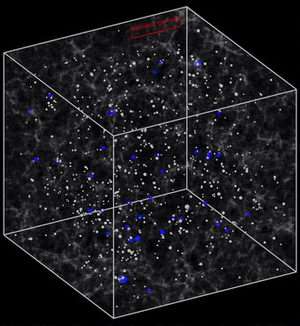Discovery Reveals that Distant Quasars Live in Massive Dark-Matter Halos

The discovery of dark-matter halos surrounding clusters of quasars that are over 10-billion light years away from Earth has been announced by an international research team of the Sloan Digital Sky Survey (SDSS).
"The survey has discovered thousands of distant quasars, and we have been able to map out their distribution in space in great detail," stated Penn State Professor of Astronomy and Astrophysics Donald Schneider, a coauthor of the investigation. "When plans for the Sloan Survey first began, the discovery of any quasar at these distances was grounds for celebration -- but now we have discovered more than 4,000 such quasars. These distant beacons reveal the structure of the distant, and very young, universe," said Schneider, who is the Chairman of the SDSS Quasar Science Group and the SDSS Scientific Publications Coordinator.
The study's results will be detailed in a paper that will be published in The Astronomical Journal titled "Clustering of High Redshift (Z > 2.9) Quasars from the Sloan Digital Sky Survey."
Quasars are glowing, ultraluminous concentrations of swirling gas falling into supermassive black holes at the centers of otherwise ordinary galaxies. Because they are extraordinarily luminous, quasars can be seen at enormous distances with current observatories. The research team used multicolor images produced by the SDSS to identify clusters of quasars. The study, led by scientists at Princeton University, revealed that these distant brilliant beacons are strongly clumped into huge quasar superclusters separated by vast stretches of empty space. "The strong clustering strongly suggests that the quasars lie within massive concentrationsof dark matter," Schneider explained.
The luminous distant quasars -- powered by black holes up to a billion times the mass of the Sun -- are extremely rare, with average separations of 200 million light years or more. Before the SDSS, only a few hundred quasars had been discovered beyond 11-billion light years, which is just the minimum distance of this new study's sample.
"Previous maps showed that more nearby quasars cluster like 'normal' galaxies," said Princeton University graduate student Yue Shen, who led the study. "But the clustering in our map is ten times stronger -- the difference between a high-contrast photograph and a washed-out photocopy." The quasar maps provide a glimpse of the structure of the universe when it was a small fraction of its current age.
"Quasars lie in galaxies, which lie in extended halos of invisible dark matter," said Princeton University astronomer Michael Strauss, a member of the research team. "In a typical galaxy, the dark matter outweighs the stars by ten to one." Scientists can't observe the dark halos directly, but by measuring the clustering of the quasars, they can infer the masses of the 'halos' in which the clusters live. "We've shown that the brightest quasars, powered by the biggest black holes, lie in the most massive halos of the early universe, several trillion times the mass of the Sun, which is roughly what theories predict," said Shen.
The new measurements shed light on the early growth of supermassive black holes, according to theorist Avi Loeb of Harvard University, who is not a member of the SDSS team. "The existence of bright quasars at early cosmic times is one of the unsolved mysteries of cosmology," Loeb said. "How did black holes grow to a billion times the mass of the Sun when the universe was only a tenth of its current age? The SDSS measurements will help us answer this question."
Source: Penn State





















